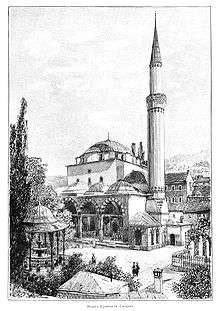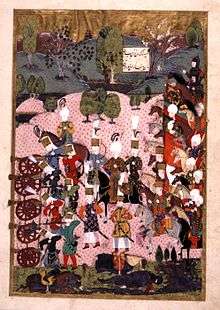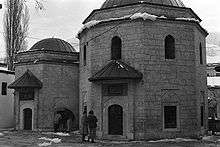Gazi Husrev-beg

Gazi Husrev-beg (Ottoman Turkish: غازى خسرو بك, Gāzī Ḫusrev Beğ; Modern Turkish: Gazi Hüsrev Bey; 1480–1541) was a Bosniak Ottoman sanjak-bey (governor) of the Sanjak of Bosnia in 1521—1525, 1526—1534, and 1536—1541. He was known for his major contribution to the improvement of the structural development of Sarajevo urban area and his construction of many important buildings there, such as the Gazi Husrev-beg Mosque or the medresa Kuršumlija, as well as for his successful conquests and for the launching of further Ottoman expansion into Croatia.
Life
Origin
He was born in Serres, Greece, to a Bosnian Muslim father Ferhad (a convert from the Trebinje region),[1] and a Turkish mother Selçuka, who was the daughter of the Sultan Bayezid II, making Gazi Husrev-Beg Beyazid II's grandson.
Career

In less than three years, he conquered the fortresses of Knin, Skradin and Ostrovica. He was appointed sanjak-bey of the Sanjak of Bosnia on 15 September 1521, becoming one of Sultan Suleiman I's most trusted men.
A relentless campaign of conquest followed soon; the fortified towns of Greben, Sokol, Jezero, Vinac, Vrbaški Grad, Livač, Kamatin, Bočac, Udbina, Vrana, Modruč, and Požega fell at his hands.
He founded, among the many buildings he ordered to construct in the city, the vakuf of Sarajevo, which was active until the 20th century.[1]

Gazi Husrev-beg played a crucial role to overcome the Christian army at the Battle of Mohács. His 10,000 Akıncıs and his irregular cavalry, composed of Turks, Bosniaks and Crimean Tatars, served as reserve soldiers in that battle. According to the Ottoman military strategy, the Akıncıs circled the European knights while the Turkish infantry made a counterfeit retreat after the first assault.
Death

Gazi Husrev-beg's forces struggled against a power vacuum in Montenegro after the death of Ottoman ally, islamized Montenegrin lord Skender-beg Crnojević in 1528. In 1541, during an uprising of Montenegro nobility, he set out to protect the Crnojevićs and the local populace. After fighting many battles to maintain order in the region, although finally victorious, he was killed while fighting Christian rebels in Mokro, a small village in Drobnjaci (present-day Montenegro). Legend states that he was a big man, so his warriors were unable to carry him, but instead of doing this, they took apart his intestines and buried them on a small hill called Hodžina glavica (Imam's Peak). However, its real connection to Gazi Husrev-beg's place of rest is unclear. His corpse was returned to Sarajevo, where it remains in a tomb in the courtyard of his mosque.
References
Sources
- Yugoslav Encyclopedia, article Husrev Beg, vol. IV, Hazim Sabanovič, Zagreb 1960
- GAMER, I, 1 (2012) s. 99-111, The other Ottoman Serhat in Europe: Ottoman territorial expansion in Bosnia and Croatia in first half of 16th century, Dino Mujadžević
| Preceded by Gazi Bali-beg Jahjapašić |
Sanjak-bey of Bosnia 15 September 1521 — 1525 |
Succeeded by Gazi Hasan-beg |
| Preceded by Gazi Hasan-beg |
Sanjak-bey of Bosnia 1526–1534 |
Succeeded by Ulama-paša |
| Preceded by Ulama-paša |
Sanjak-bey of Bosnia 1536–1541 |